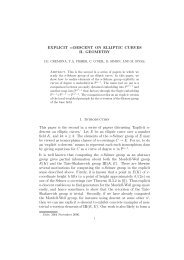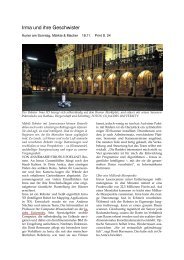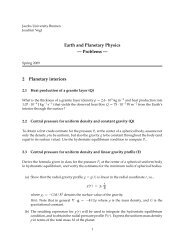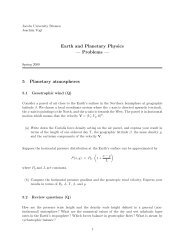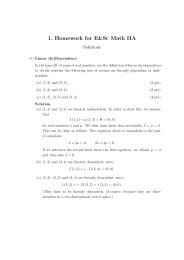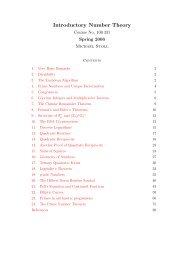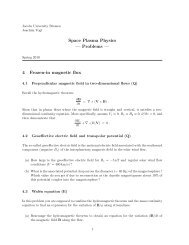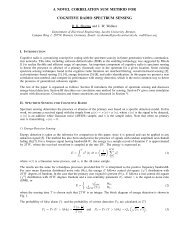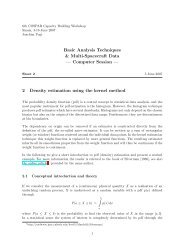Linear Algebra II (pdf, 500 kB)
Linear Algebra II (pdf, 500 kB)
Linear Algebra II (pdf, 500 kB)
Create successful ePaper yourself
Turn your PDF publications into a flip-book with our unique Google optimized e-Paper software.
14<br />
5.6. Application. One important application of the Jordan Normal Form Theorem<br />
is to the explicit solution of systems of linear first-order differential equations<br />
with constant coefficients. Such a system can be written<br />
d<br />
y(t) = A · y(t) ,<br />
dt<br />
where y is a vector-valued function and A is a matrix. One can then show (Exercise)<br />
that there is a unique solution with y(0) = y0 for any specified initial value y0,<br />
and it is given by<br />
y(t) = exp(tA) · y0<br />
with the matrix exponential<br />
exp(tA) =<br />
∞<br />
n=0<br />
t n<br />
n! An .<br />
If A is in Jordan Normal Form, the exponental can be easily determined. In<br />
general, A can be transformed into Jordan Normal Form, the exponential can be<br />
evaluated for the transformed matrix, then we can transform it back — note that<br />
exp(tP −1 AP ) = P −1 exp(tA)P .<br />
5.7. Remark. What can we do when the characteristic polynomial does not split<br />
into linear factors (which is possible when the field F is not algebraically closed)?<br />
In this case, we have to use a weaker notion than that of diagonalizability. Define<br />
the endomorphism f : V → V to be semi-simple if every f-invariant subspace<br />
U ⊂ V has an f-invariant complementary subspace in V . One can show (Exercise)<br />
that if the characteristic polynomial of f splits into linear factors, then f is semisimple<br />
if and only if it is diagonalizable. The general version of the Jordan Normal<br />
Form Theorem then is as follows.<br />
Let V be a finite-dimensional vector space, f : V → V an endomorphism. Then<br />
f = s + n with endomorphisms s and n of V such that s is semi-simple, n is<br />
nilpotent, and s ◦ n = n ◦ s.<br />
Unfortunately, we do not have the means and time to prove this result here.<br />
However, we can state the result we get over F = R.<br />
5.8. Theorem (Real Jordan Normal Form). Let V be a finite-dimensional<br />
real vector space, f : V → V an endomorphism. Then there is a basis of V such<br />
that the matrix representing f with respect to this basis is a block diagonal matrix<br />
with blocks of the form B(λ, m) and of the form (with µ > 0)<br />
B ′ ⎛<br />
λ −µ 1 0 · · · 0 0 0<br />
⎞<br />
0<br />
⎜<br />
µ<br />
⎜0<br />
⎜<br />
⎜0<br />
⎜<br />
(λ, µ, m) = ⎜ .<br />
⎜<br />
⎜0<br />
⎜<br />
⎜0<br />
⎝0<br />
λ<br />
0<br />
0<br />
.<br />
0<br />
0<br />
0<br />
0<br />
λ<br />
µ<br />
.<br />
0<br />
0<br />
0<br />
1<br />
−µ<br />
λ<br />
.<br />
0<br />
0<br />
0<br />
· · ·<br />
· · ·<br />
· · ·<br />
...<br />
· · ·<br />
· · ·<br />
· · ·<br />
0<br />
0<br />
0<br />
.<br />
λ<br />
µ<br />
0<br />
0<br />
0<br />
0<br />
.<br />
−µ<br />
λ<br />
0<br />
0<br />
0<br />
0<br />
.<br />
1<br />
0<br />
λ<br />
0 ⎟<br />
0 ⎟<br />
0 ⎟<br />
.<br />
⎟ ∈ Mat(R, 2m) .<br />
0<br />
⎟<br />
1 ⎟<br />
−µ ⎠<br />
0 0 0 0 · · · 0 0 µ λ<br />
Blocks B(λ, m) occur for eigenvalues λ of f; blocks B ′ (λ, µ, m) occur if Pf(x) is<br />
divisible by x 2 − 2λx + λ 2 + µ 2 .



